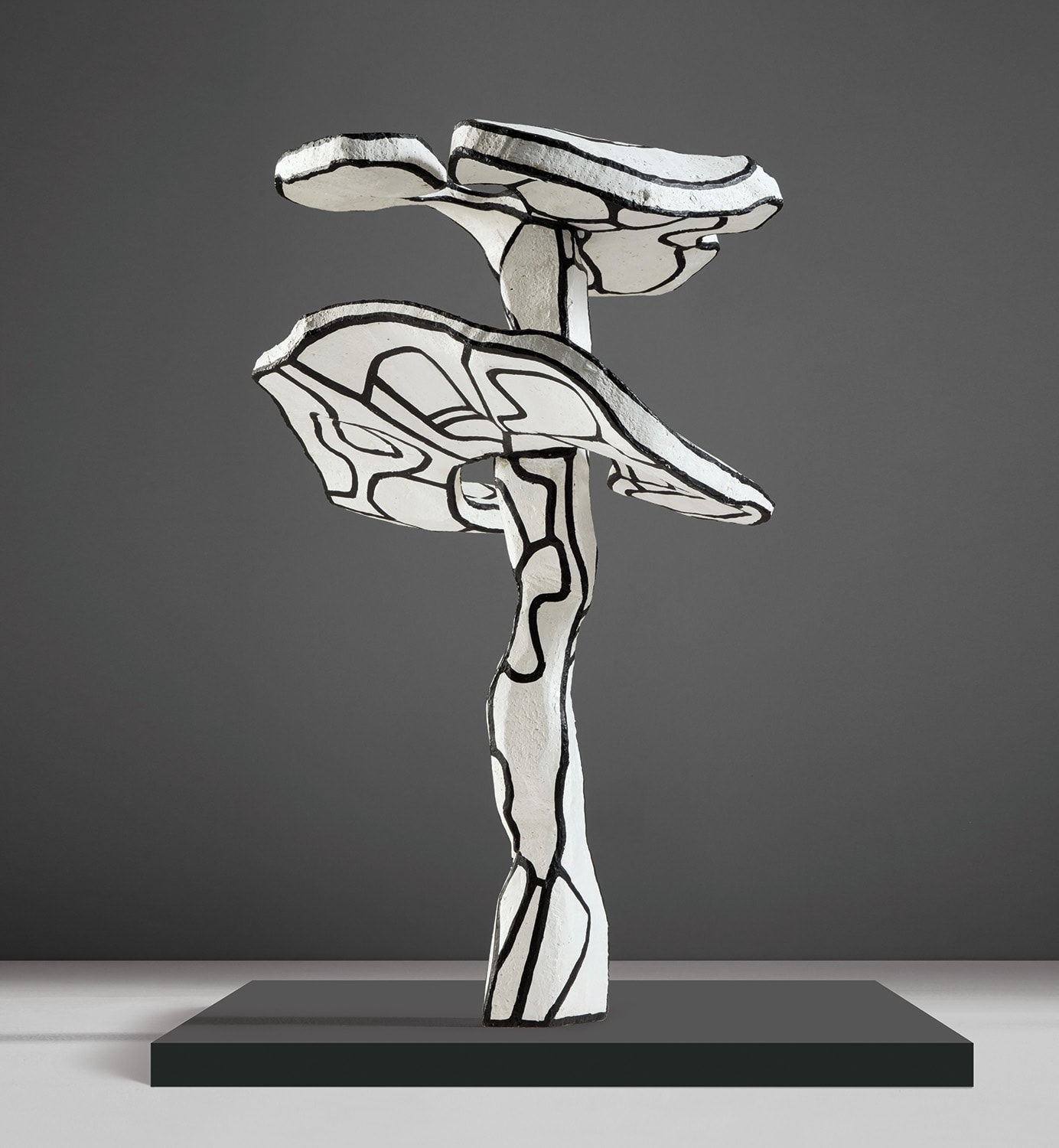

Property from the Miles and Shirley Fiterman Collection
116Ο
Jean Dubuffet
Arbre aux deux étages
signed with the artist's initials and dated "J.D. 70" along the lower edge
epoxy paint on polyurethane
34 5/8 x 19 5/8 x 22 in. (88 x 50 x 56 cm.)
Executed on August 17, 1970.
Full-Cataloguing
"It is not in fact painted sculpture itself, but rather a monumentally erected painting." - Jean Dubuffet
Giving three-dimensional form to Jean Dubuffet’s graphic universe, Arbre aux deux étages, 1970, belongs to the iconic series of sculptures that evolved from the artist’s acclaimed L’Hourloupe cycle. True to the series' instantly recognizable forms covered with bold black line, the work interprets the structure of a two-tiered tree through a jigsaw-like configuration defined by thick black outlines. As one of only around a dozen Arbre sculptures, the present work is intimately connected to Dubuffet’s first monumental public sculpture Groupe de quatre arbres, commissioned by David Rockefeller in 1969 and inaugurated in 1972 at the Chase Manhattan Plaza in New York where it stands to this day.
Executed in 1970, Arbre aux deux étages captures a critical moment in Dubuffet’s development of his Hourloupe cycle from painting into a vast multi-media universe. It was in 1962, inspired by a series of pen doodles he had created whilst talking on the telephone, that Dubuffet embarked upon what Thomas M. Messer described as, “arguably the most radical structural reinterpretation since Cubism” (Thomas M. Messer, "Jean Dubuffet (1901-1985): A Summary", in Jean Dubuffet and Art Brut, exh. cat., Peggy Guggenheim Collection, Venice, 1986, p. 24). Dubuffet, who for the past 20 years had dedicated himself to seeking out raw, unmediated modes of expression, saw in these semi-automatic drawings the potential to access the inner workings of the mind. While initially creating drawings and paintings, Dubuffet notably pushed his practice into the third dimension with this series. Yet rather than defining works such as the present one as sculptures in the traditional sense, Dubuffet thought of them as “unleashed graphisms”, or "drawings which extend and expand in space” (Jean Dubuffet, "Remarks on the unveiling of the Group of Four Trees”, in Jean Dubuffet, Asphyxiating culture and other writings, New York, 1988, p. 117).
Representing the purest articulation of line in space, Arbre aux deux étages appears as if lifted off the page or canvas of Dubuffet's self-contained graphic universe. To achieve this sense of weightlessness and graphic clarity, Dubuffet would first create a maquette from a block of polystyrene – using a hot wire to construct his form with an immediacy and preciseness that paralleled his act of drawing on paper. He then realized the form in polyurethane, a material he was entranced with for its lightness and ethereal white sheen. As Dubuffet explained, "The spiritual exercise of integration and intimate unification of the physical with the mental world is aided by several factors, among which must be mentioned the astonishing lightness of the material used, by which the mind is moved to abolish the notion of weight from the objects of the physical world” (Jean Dubuffet, "Note on the Painted Polystyrene Hourloupe Pieces”, in Jean Dubuffet: Writings on Sculpture, Dusseldorf, 2011, p. 54).
Giving three-dimensional form to Jean Dubuffet’s graphic universe, Arbre aux deux étages, 1970, belongs to the iconic series of sculptures that evolved from the artist’s acclaimed L’Hourloupe cycle. True to the series' instantly recognizable forms covered with bold black line, the work interprets the structure of a two-tiered tree through a jigsaw-like configuration defined by thick black outlines. As one of only around a dozen Arbre sculptures, the present work is intimately connected to Dubuffet’s first monumental public sculpture Groupe de quatre arbres, commissioned by David Rockefeller in 1969 and inaugurated in 1972 at the Chase Manhattan Plaza in New York where it stands to this day.
Executed in 1970, Arbre aux deux étages captures a critical moment in Dubuffet’s development of his Hourloupe cycle from painting into a vast multi-media universe. It was in 1962, inspired by a series of pen doodles he had created whilst talking on the telephone, that Dubuffet embarked upon what Thomas M. Messer described as, “arguably the most radical structural reinterpretation since Cubism” (Thomas M. Messer, "Jean Dubuffet (1901-1985): A Summary", in Jean Dubuffet and Art Brut, exh. cat., Peggy Guggenheim Collection, Venice, 1986, p. 24). Dubuffet, who for the past 20 years had dedicated himself to seeking out raw, unmediated modes of expression, saw in these semi-automatic drawings the potential to access the inner workings of the mind. While initially creating drawings and paintings, Dubuffet notably pushed his practice into the third dimension with this series. Yet rather than defining works such as the present one as sculptures in the traditional sense, Dubuffet thought of them as “unleashed graphisms”, or "drawings which extend and expand in space” (Jean Dubuffet, "Remarks on the unveiling of the Group of Four Trees”, in Jean Dubuffet, Asphyxiating culture and other writings, New York, 1988, p. 117).
Representing the purest articulation of line in space, Arbre aux deux étages appears as if lifted off the page or canvas of Dubuffet's self-contained graphic universe. To achieve this sense of weightlessness and graphic clarity, Dubuffet would first create a maquette from a block of polystyrene – using a hot wire to construct his form with an immediacy and preciseness that paralleled his act of drawing on paper. He then realized the form in polyurethane, a material he was entranced with for its lightness and ethereal white sheen. As Dubuffet explained, "The spiritual exercise of integration and intimate unification of the physical with the mental world is aided by several factors, among which must be mentioned the astonishing lightness of the material used, by which the mind is moved to abolish the notion of weight from the objects of the physical world” (Jean Dubuffet, "Note on the Painted Polystyrene Hourloupe Pieces”, in Jean Dubuffet: Writings on Sculpture, Dusseldorf, 2011, p. 54).